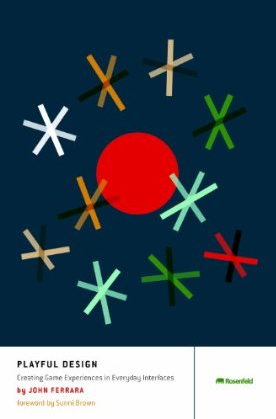It’s a long time ago, since I heard the last time something from John Maeda. But here is a new TED-Talk Maeda gave. The biggest effort from Maeda in general is to combine the art and design perspective with business and technology. And so is this talk as well. On the one hand, no extremely new perspectives, that Maeda offers in this talk. On the other hand, it is always important to remeber to good old basics when it comes to art, design and perception. At the end of the presentation, he comes up with the vision of “creative leadership” and mocks up a special designed interactive tool, for leading a medium sized business. (via phlow, thx!)
A short, but essential video about all this little hidden games, we somehow used to play (and still do). Add your own! #gamesweplay Video by Follow the Foot.
(via Krystman, thx!)

Most recently John Ferrara published a book called “Playful Design“, that tries to bridge the gap between “everyday user-interfaces” and “game design“. It is aimed at user-experience-designers, who want to try to make their apps more sticky and more meaningful for the users. Here is the link to the Table of Contents.
The “Netmagazine” published an edited version of the chapter “Ten tips for building a better game“, with sentences like this:
“Consider what makes a game intrinsically interesting. You’ll find a lot of creative opportunity in games that make the player think through interesting choices instead of executing twitch responses.”
All in all, this book looks like a very nice lecture for both game- and user-experience-designers.

The Creative Applications-blog has got a very good read about good ways to organize visual patch programming languages like vvvv or maxMSP. It deals about top-down and commented vs. chaotic and almost non-organized. It talks about levels of complexity as well. The article talks also about aesthetics. Sure, if we are honest, we all foremost like patching languages not only because the are handy, but also because they most often look extremely pleasing to the eye.
Some Demosceners came up with the idea “how much music you can make with one line of code“. It didn’t take long, and some guys came up with some code to experiment with: just put it some strangely technical code onto the software and let the result be heard. After that it didn’t take long and some other guy build a JavaScript-environmnt around this program to make it on the web. After that, some visualizing goodness was added to the thing. You can try it out for yourself at this site.
And this is how it looks like:
Cool thing – it remembers me on some other experiments from the last years, like Tweet-a-sound, Tweetcoding in ActionScript3 or demo in less than 140 characters.
This is a talk of Marius Watz from the Eyeo Festival. It about code, form, art and code as a form of art… ;) (Sorry for this pun.) Indeed code and code as an expressive artistic medium is one of the topics, that really interests me right at the moment. There will be stuff going on by the way, I will post some news in few weeks. (Just a hint, I work on a scripting-framework for FabLabs and CNC-machines). Okay, enough from me, let’s roll the talk!
Petri Purho, known to the most people as Klooniegames for his quite successful game Crayon Physics Deluxe (this is also part of the Humble IndieGame Bundle 3 by the way), held a talk at the Assembly 2011. He talks about why “being poor or having no budget is good for making games”. It is about making decisions based upon limitation and how this pushes being creative on the subject of innovation.

